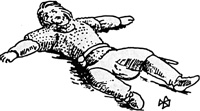 For many years I have been completely dissatisfied with wargaming in the accepted sense, in that after a collision of forces and a result is achieved there is no visible sign of the conflict. I have written before on the subject of "Fallen Hero's" and fortunately being a solo player can incorporate them in my games. What brought this to the fore again when I was reading a passage from Bernard Cornwell's The Winter King based on King Arthur, in what to my mind is the most realistic novel I have read on the subject.
For many years I have been completely dissatisfied with wargaming in the accepted sense, in that after a collision of forces and a result is achieved there is no visible sign of the conflict. I have written before on the subject of "Fallen Hero's" and fortunately being a solo player can incorporate them in my games. What brought this to the fore again when I was reading a passage from Bernard Cornwell's The Winter King based on King Arthur, in what to my mind is the most realistic novel I have read on the subject.
The part of the book I am really interested in is the fight at a ford across a river between two shieldwalls. In the first encounter both sides meet in the river and the front rank warriors crouch beneath their shields and push against the enemy. Very little damage done to both sides until the "baddies" fall back and then there is room and time for killing the injured enemy. Both sides fell back to the river bank and got their breath back.
Shortly a second attack was launched and not only did the attackers have to wade through the river but also negotiate the fallen from the first encounter. This second attack was defeated in detail and the defenders stripped the fallen of the armour, jewellery etc and "left their bodies at the ford's edge as a barrier to the next attack". It is at this point in a game that after two attacks there should be a barrier of fallen showing the location of the combat, but our miniature heroes are whisked off to their mini metal Valhalla and never seen again.
Pretend Bodies
Anyone who has taken part in an ECW or Dark Ages re-enactment will know that even "pretend bodies" can cause disorganisation to a pike block or shieldwall. I believe this is an important part of a game that all rule writers I have read tend to ignore, properly for their own reasons. Irrespective of other factors involved in a melee if a unit has held its ground and beaten off the attack I place a Fallen Heroes marker in front of them.
This is just an irregular shaped piece of card with some figures, (who didn't make it intact through the post), stuck to it or better still using the Ancient casualties figures from Frie Korps 15. This marker applies to cavalry, chariots, camels and wagons, all of which having been broken would have ended up being thrown out. Nearly forgot to mention Elephants! Imagine a unit trying to keep formation crossing a fallen elephant, no way, they would flow (?) around it and I would guess that close order troops like a phalanx or cohort never included "flowing" in their drill manual.
I can now see at a glance that a melee took place in front of a unit. I count any unit attacking across the marker to get into melee by grading them as being disordered for crossing difficult ground. This was really brought to the fore while watching the Ivanhoe series on BBC 1 and the fighting sequences were up to "Braveheart" standard with many bundles lying around.
So don't throw out those broken figures! Give them a rough paint job and give them some employment. This aspect combined with other methods outlined in Lone Warrior for moving troops will certainly add to ones lack of control over your miniature heroes. You have been warned and please do not try this at a club - they don't like it!
[These columns (the layout) are dedicated to Will Johnson who wrote and said he liked them. Kenn]
Related:
Back to Table of Contents -- Lone Warrior #118
Back to Lone Warrior List of Issues
Back to MagWeb Magazine List
© Copyright 1997 by Solo Wargamers Association.
This article appears in MagWeb (Magazine Web) on the Internet World Wide Web.
Other military history articles and gaming articles are available at http://www.magweb.com
